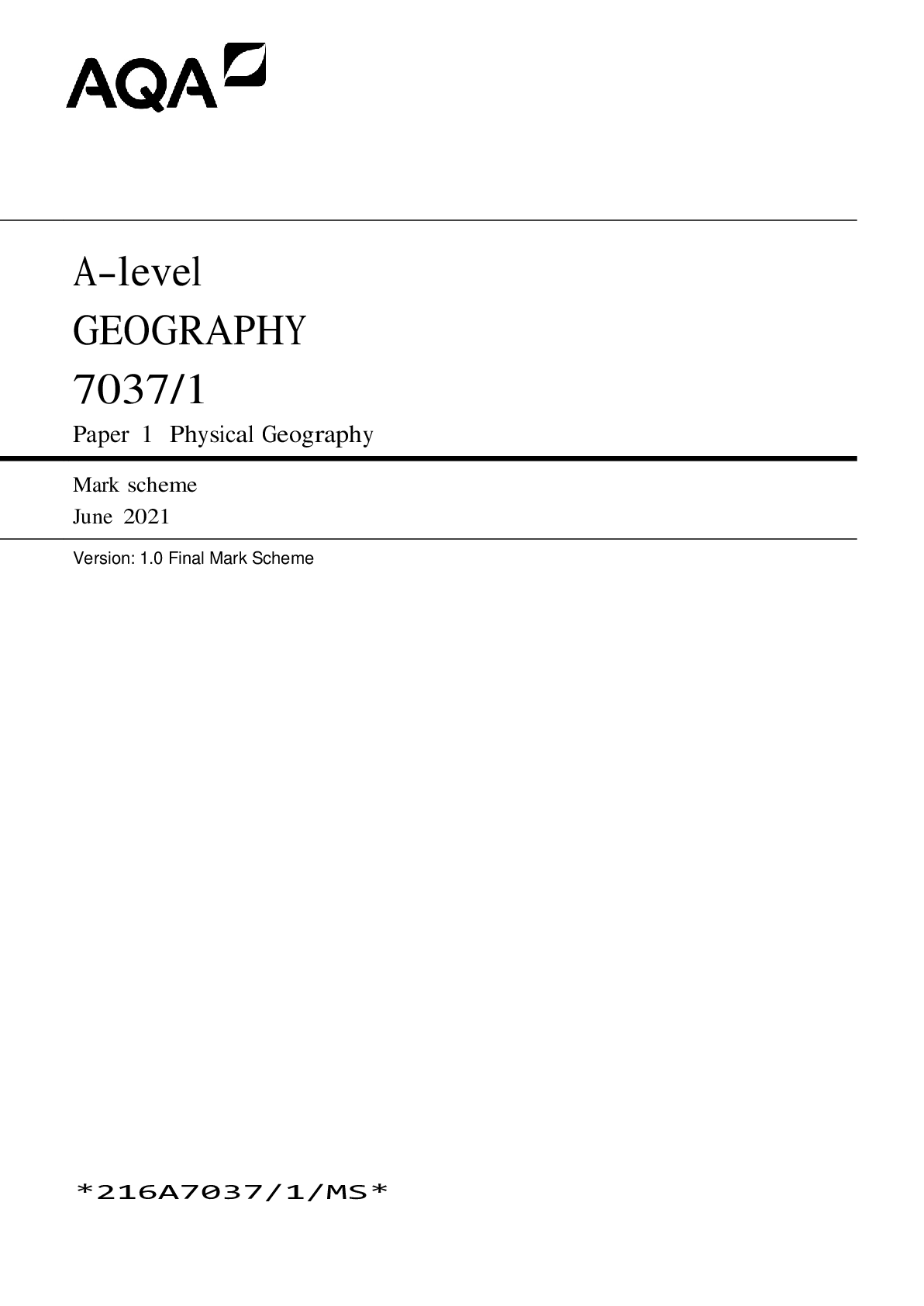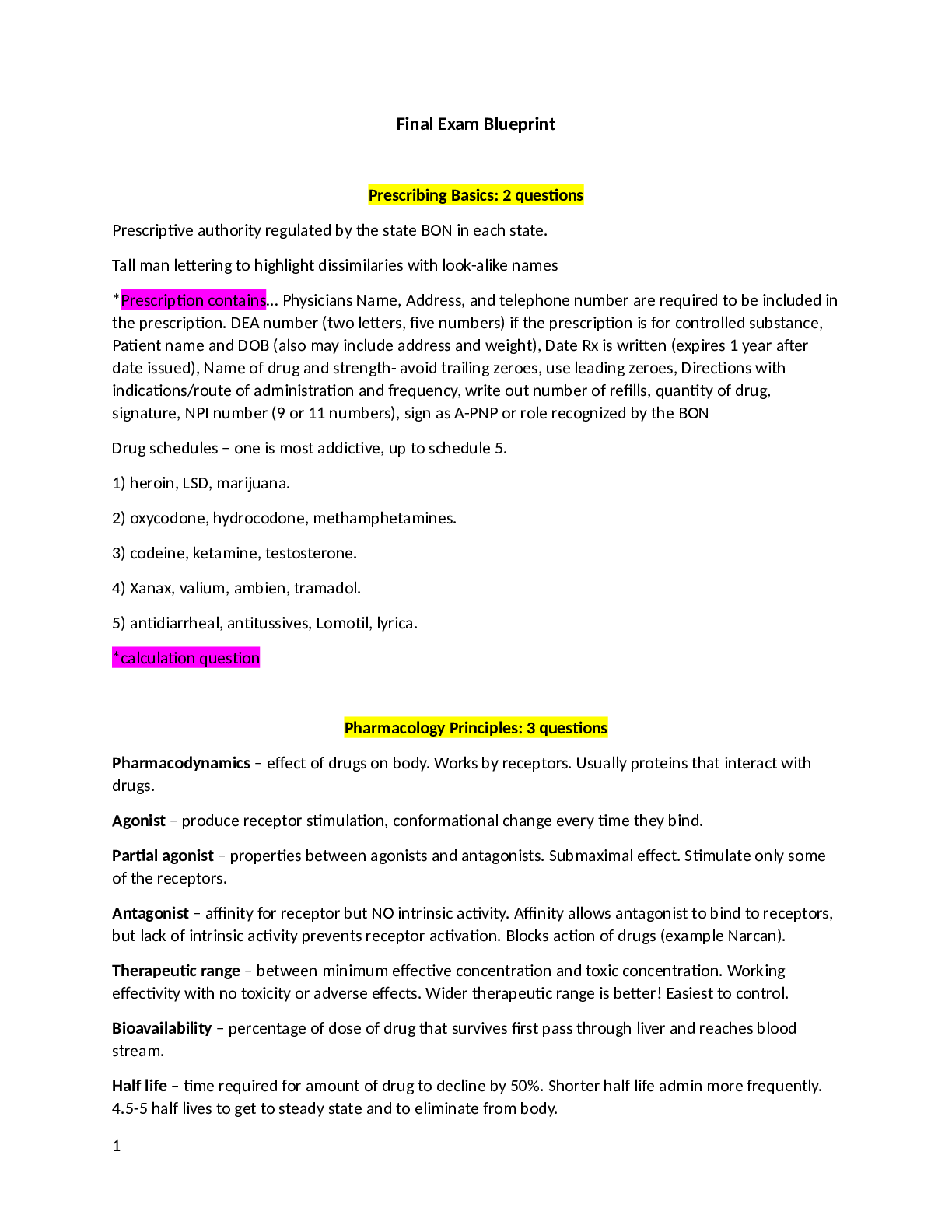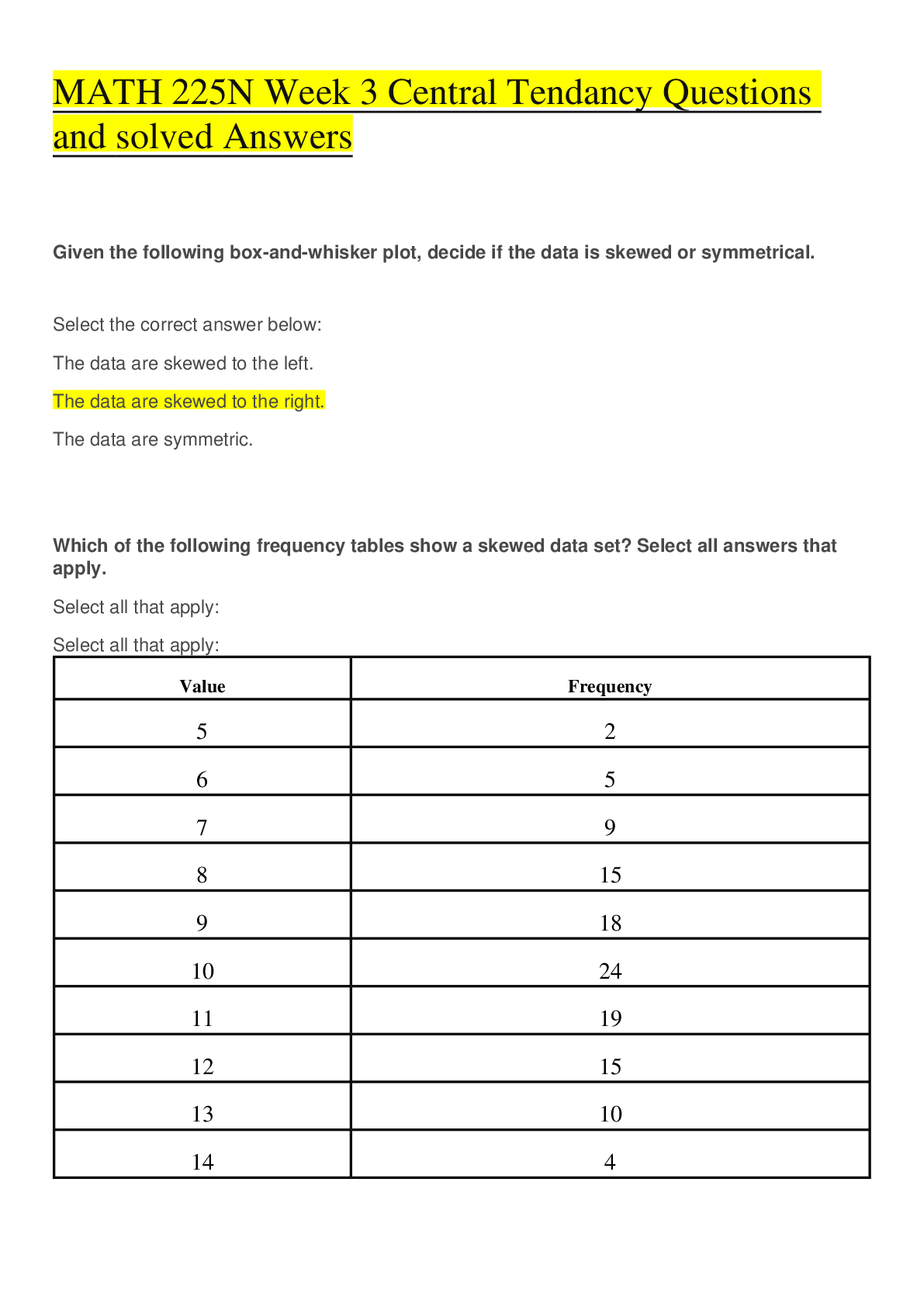Geography > EXAM > A-level GEOGRAPHY 7037/1 Paper 1 Physical Geography ALL ANSWERS 100% CORRECT SPRING FALL-2022 LATEST (All)
A-level GEOGRAPHY 7037/1 Paper 1 Physical Geography ALL ANSWERS 100% CORRECT SPRING FALL-2022 LATEST GUARANTEED GRADE A+
Document Content and Description Below
Qu Part Marking guidance Total marks 01 1 Outline the relationship between the water cycle and the carbon cycle in the atmosphere. Point marked Allow 1 mark per valid point with extra mark(s) f... or developed points (d). For example: Notes for answers • Increasing concentrations of carbon (and Methane) in the atmosphere has a warming effect on the planet and leads to increased evaporation (1). This can increase rates of precipitation or equally higher rates of evaporation can further exacerbate aridity (1) (d). • Volcanic eruptions release both carbon dioxide and water vapour into the atmosphere (1). • Photosynthesis requires both precipitation and carbon dioxide (1). • Decomposition releases carbon dioxide and requires the presence of water (1). Some may link this to the melting of permafrost, which is a significant contributor to CO2 release (1) (d). • Some may consider the acid rain as an outcome of the relationship between water and carbon on the atmosphere (1). This may be further linked to ocean acidification (1) (d). The notes for answers are not exhaustive. Credit any valid points. 4 AO1=4 01 2 Analyse the data shown in Figure 1. AO3 – There should be clear analysis of the relationships evident in the resource. Analysis should consider the relationship between forest cover, land surface temperature and latitude. Mark scheme Level 2 (4–6 marks) AO3 – Clear analysis of the quantitative evidence provided, which makes appropriate use of data in support. Clear connection(s) between different aspects of the data and evidence. Level 1 (1–3 marks) AO3 – Basic analysis of the quantitative evidence provided, which makes limited use of data and evidence in support. Basic connection(s) between different aspects of the data and evidence. 6 AO3=6 Notes for answers AO3 • Afforestation is more likely to lead to a reduction in land surface temperature. The most extreme temperature decreases can be seen where temperatures fall by up to 1.7oC at latitudes -25oS and a reduction in 50–70% surface cover. • Some obvious anomalies exist eg at 5oS, 10%–30% afforestation appears to lead to a small temperature increase. Similarly at around 40os, up to 50% afforestation leads to temperature decrease but at 60% afforestation, temperatures appear to increase. The highest latitudes also tend to see temperature increases with afforestation, more so in the northern hemisphere, though here data extends to 75oN, compared to only 55oS. • The pattern is arguably less predictable for deforestation. As a generalisation increasing deforestation leads to higher land surface temperatures with figures up to 1.7oC noted between 15oN and 15oS. • Between 55 and 75oN, almost any deforestation leads to temperature decrease and at around 45oN, with 70% decrease in forest, there is a significant drop in land surface temperature. • Some may note the lack of data particularly between 25oN and 15oS. This does make it more difficult to identify patterns within the data at these latitudes and also makes it more difficult to compare latitudes. • Some may consider deforestation in isolation and look for variation in patterns here. This is creditworthy at Level 1. Credit any other valid analysis. 01 3 Using Figure 2 and your own knowledge, assess the implications of the data for attempts to manage carbon transfers. AO1 – Knowledge and understanding of the carbon cycle. AO2 – Application of knowledge to show how effective understanding and managing carbon transfers can impact upon carbon storage. Mark scheme Level 2 (4–6 marks) AO1 – Demonstrates clear knowledge and understanding of concepts, processes, interactions and change. AO2 – Applies knowledge and understanding to the novel situation offering clear evaluation and analysis drawn appropriately from the context provided. Connections and relationships between different aspects of study are evident with clear relevance. Level 1 (1–3 marks) AO1 – Demonstrates basic knowledge and understanding of concepts, processes, interactions, change. 6 AO1=2 AO2=4 AO2 – Applies limited knowledge and understanding to the novel situation offering only basic evaluation and analysis drawn from the context provided. Connections and relationships between different aspects of study are basic with limited relevance. Notes for answers AO1 • Global distribution, and size of major stores of carbon – lithosphere, hydrosphere, cryosphere, biosphere, atmosphere. • Factors driving change in the magnitude of these stores over time and space, including flows and transfers at plant, sere and continental scales. Photosynthesis, respiration, decomposition, combustion, carbon sequestration in oceans and sediments, weathering. Changes in the carbon cycle over time, to include natural variation (including wild fires, volcanic activity) and human impact (including hydrocarbon fuel extraction and burning, farming practices, deforestation, land use changes). • The carbon budget and the impact of the carbon cycle upon land, ocean and atmosphere, including global climate. • Human interventions in the carbon cycle designed to influence carbon transfers and mitigate the impacts of climate change. AO2 • Responses should note that any management should seek to control the release of carbon from forests into the atmosphere as well as increase the uptake of carbon by expanding forests and increasing rates of photosynthesis. • The data suggests that European forests absorb more carbon than is released. It also suggests that more could be done to help with the absorption of carbon especially considering the amount that is released through burning fossil fuels. Fires release 7 TgC. A strategy to reduce wildfire could help reduce the amount released by uncontrolled burning or wildfire. • Similarly better use of waste from wood products could reduce decomposition and the burning of this could reduce fossil fuel use. In this sense some may argue that burning wood as a fuel source is carbon neutral as only a small amount is stored following decomposition. The wood burning for fuel could reduce emissions from burning fossil fuels ie an indirect benefit. • Some may suggest that afforestation schemes may reduce the rainsplash impact and soil erosion. This could reduce the 15 TgC lost in river carbon flow. • Making better use of wood in construction could reduce the reliance on energy intensive products. In this sense the forest could reduce carbon emissions more indirectly. • Some may consider sequestration as method to control the carbon released through decomposition. Credit any other valid assessment. 01 4 With reference to a river catchment that you have studied, assess the potential factors which can impact upon the flood hydrograph. AO1 – Knowledge and understanding of the flood hydrograph and factors affecting the shape of it. K/U of a chosen case study of a river catchment. AO2 – Application of knowledge and understanding assess the impact of environmental factors, development and / or conservation on the hydrograph. Notes for answers AO1 • Drainage basins as open systems – inputs and outputs, to include precipitation, evapo-transpiration and runoff; stores and flows, to include interception, surface, soil water, groundwater and channel storage; stemflow, infiltration overland flow, and channel flow. Concept of water balance. • Runoff variation and the flood hydrograph. • Changes in the water cycle over time to include natural variation including storm events, seasonal changes and human impact including farming practices, land use change and water abstraction. • Case study of a river catchment(s) at a local scale to illustrate and analyse the key themes above, engage with field data and consider the impact of precipitation upon drainage basin stores and transfers and implications for flooding. AO2 • Responses are expected apply their knowledge of factors affecting the flood hydrograph to their chose case study of a river catchment. • Land use and other human activities influence the peak discharge of floods by modifying how rainfall is stored on and run off the land surface into streams. In undeveloped areas such as forests and grasslands, rainfall and snowmelt collect and are stored on vegetation, in the soil, or in surface depressions. When this storage capacity is filled, runoff flows slowly through soil, this reducing the flashiness of the hydrograph. • In contrast, urban areas, where much of the land surface is covered by roads and buildings, have less capacity to store rainfall and snowmelt. Construction of roads and buildings often involves removing vegetation, soil, and depressions from the land surface. The permeable soil is replaced by impermeable surfaces such as roads, roofs, concrete and tarmac surfaces, store little water, reduce infiltration of water into the ground, and accelerate runoff to ditches and streams. Even in suburban areas, where lawns and other permeable landscaping may be common, rainfall and snowmelt can saturate thin soils and produce overland flow, which runs off quickly. Once water enters a drainage network, it flows faster than either overland or subsurface flow. • Expect to see reference to specific case study detail eg Streamflow in Mercer Creek, an urban stream in western Washington, increases 20 AO1=10 AO2=10 [Show More]
Last updated: 2 years ago
Preview 1 out of 45 pages

Buy this document to get the full access instantly
Instant Download Access after purchase
Buy NowInstant download
We Accept:

Reviews( 0 )
$7.50
Can't find what you want? Try our AI powered Search
Document information
Connected school, study & course
About the document
Uploaded On
Jun 13, 2022
Number of pages
45
Written in
Additional information
This document has been written for:
Uploaded
Jun 13, 2022
Downloads
0
Views
130


























